The global baby care products market size was valued at $38.0 billion in 2021, and is projected to reach $58.8 billion by 2031, growing at a CAGR of 4.5% from 2022 to 2031.
The baby care products market is expanding as a result of growing parental concerns about their children's skin. In addition, infant skin must be shielded from dirt exposure as it is typically sensitive. People are more likely to select skin care products owing to rise in awareness regarding hygiene and overall health of babies. Moreover, kids are more prone to develop chronic diseases and attract microorganisms that lead to diseases. Many companies have devised unique solutions to illustrate the importance of hygiene in babies and how this might affect their health.
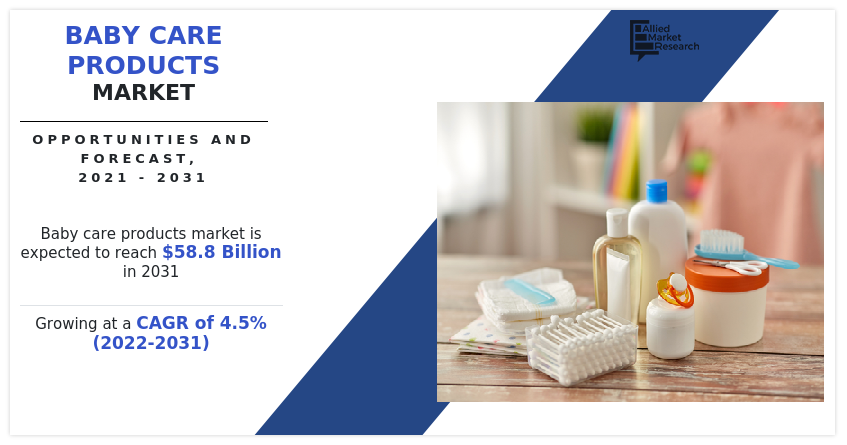
For their infants, the majority of parents choose homemade baby food to packaged baby food. This pattern has changed, nevertheless, as a result of time demands placed on food preparation as a result of the greater engagement of women in the workforce and growing dietary concerns. Moreover, high price of the baby food products has hampered their adoption among middle-income groups. In addition, due to a lack of knowledge about these items, consumers favor home-cooked food in rural and isolated areas. Promotional efforts and reasonably priced infant food items are expected to result in an overall rise in the market's revenue generation.
The market is segmented into product type, price point, distribution channel, and region. On the basis of product type, the market is classified into baby skin care, baby hair care, baby food & beverage, and others. By price point, it is bifurcated into low, medium, and high. As per distribution channel, it is categorized into supermarkets & hypermarkets, drug stores or pharmacy, mass merchandiser, departmental stores, mono-brand stores, specialty stores, online sales channel, and others. Region-wise, the market is analyzed across North America, Europe, Asia-Pacific, and LAMEA.
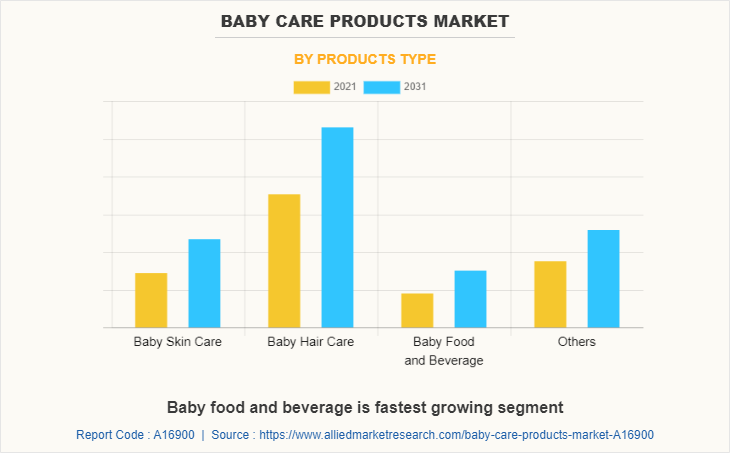
The baby hair care segment dominates the global baby care products market. This is mostly caused by the rise in proportion of working women in these nations. A number of factors, including rise in discretionary income, new product launches, and rapid urbanization, are expected to affect the sales volume during the forecast period. This market is expanding as a result of the emergence of organized retail, which ensures accessibility of cutting-edge goods and multinational brands with specialized features.
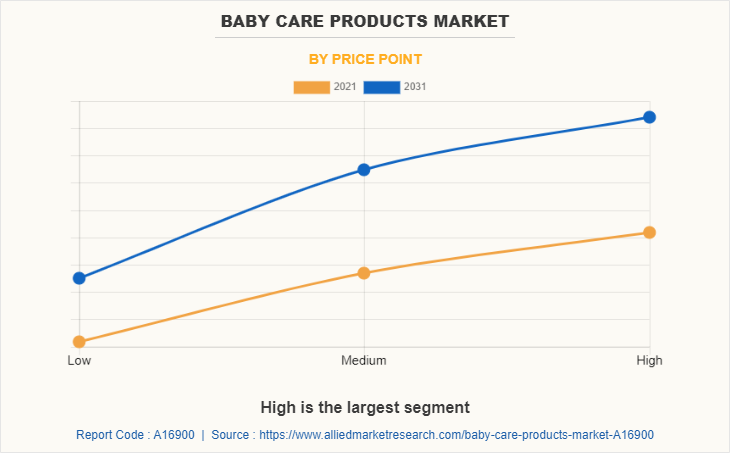
The medium segment exhibits the fastest growth, owing to rise in preference for natural and organic products at reasonable prices. Developing regions of North America and LAMEA are anticipated to provide great opportunities to the market during the forecast period. This is attributed to the existence of market players and unexplored market opportunities in nations such as the U.S. and UK.
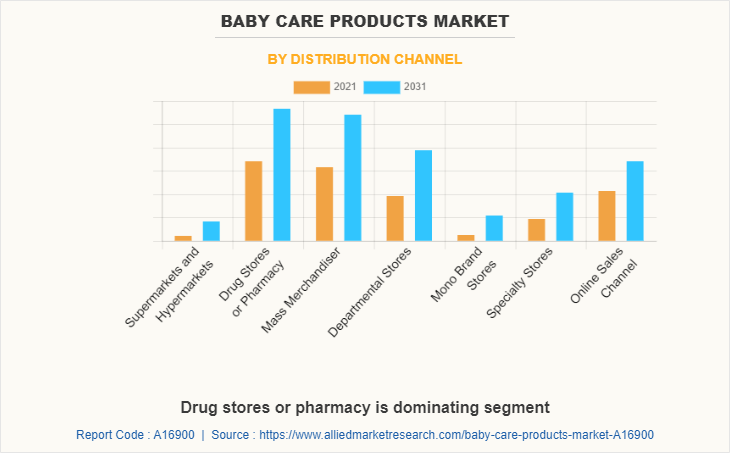
Consumers purchase baby care products by various distribution channels, including supermarkets & hypermarkets, specialty stores, online sales channel, and others. The online sales channel is growing at the highest rate, owing to benefits provided, such as discounts and free home delivery.
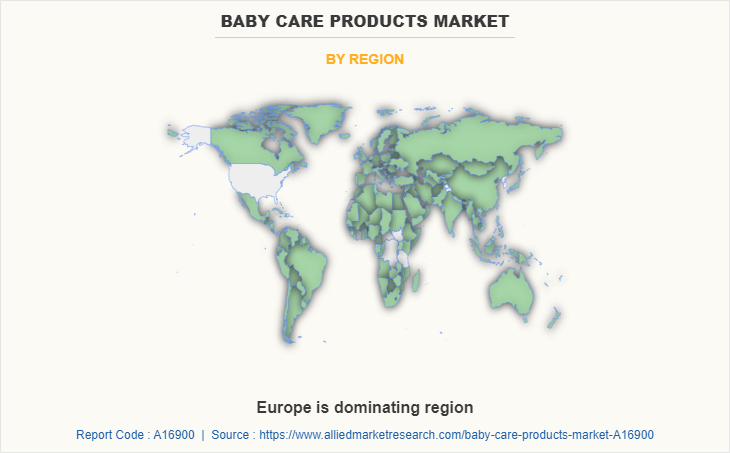
Region-wise, Europe dominates the market with largest baby care products market share during the baby care products market forecast period. Baby care products and their different varieties are the mostly purchased in Asia-Pacific, especially in Japan, India, and China. The preference for baby care products with different organic and natural ingredients changes with different geographical locations. In addition, the growing preference for nutritious and healthy baby food products as well as increase in demand for formula-based baby food and beverage products are driving the baby care products market growth in Asia-Pacific. The demand for baby care products in this region is expected to rise over the next few years as a result of rise in health and hygiene awareness, urbanization, rise in living standards, and rise in levels of disposable income.
The major players analyzed for the baby care products industry are Baby Brezza, Beiersdorf, California Baby, Cotton Babies Inc., Dorel Industries Inc., Helen of Troy Limited, Johnson & Johnson, Kimberly-Clark, Koninklijke Philips N.V., Munchkin, Inc., Nestle SA, Procter & Gamble (P&G), Sebapharma GmbH & Co. KG, and Unilever.
Key Benefits For Stakeholders
- This report provides a quantitative analysis of the market segments, current trends, estimations, and dynamics of the baby care products market analysis from 2021 to 2031 to identify the prevailing baby care products market opportunities.
- The market research is offered along with information related to key drivers, restraints, and opportunities.
- Porter's five forces analysis highlights the potency of buyers and suppliers to enable stakeholders make profit-oriented business decisions and strengthen their supplier-buyer network.
- In-depth analysis of the baby care products market segmentation assists to determine the prevailing market opportunities.
- Major countries in each region are mapped according to their revenue contribution to the global market.
- Market player positioning facilitates benchmarking and provides a clear understanding of the present position of the market players.
- The report includes the analysis of the regional as well as global baby care products market trends, key players, market segments, application areas, and market growth strategies.
Baby Care Products Market Report Highlights
| Aspects | Details |
| Market Size By 2031 | USD 58.8 billion |
| Growth Rate | CAGR of 4.5% |
| Forecast period | 2021 - 2031 |
| Report Pages | 305 |
| By Products Type |
|
| By Price Point |
|
| By Distribution Channel |
|
| By Region |
|
| Key Market Players | Munchkin, Inc., sebapharma gmbh & co. kg, Nestle SA, Baby Brezza, beiersdorf, Procter & Gamble (P&G), California Baby, Johnson & Johnson, kimberly-clark, Cotton Babies Inc. |
Analyst Review
According to the insights of CXOs of leading companies, the market for baby care products offers significant potential to market participants. Baby hygiene care has improved, birth rates have increased, and more women are working, all of which have helped the market expand. Many large corporations, including Johnson & Johnson Consumer Inc., make an effort to keep the amount of chemicals in their baby powder and shampoos to a minimum. To raise public awareness about diaper consumption, businesses like Kimberly Clark team up with diaper banks. To increase awareness of the advantages of infant toiletries and spur market expansion, major players in the industry are creating a variety of cutting-edge strategies.
CXOs further added that these firms have increased the market share of their baby food products by engaging in research and development activities and innovations to enhance the flavors and ingredients of baby food. Contrary to residents of semi-urban and urban areas, urban residents have started using packaged food goods in recent years. People's busy lifestyles have led them to use prepared baby food and newborn formula. The acceptance of baby food items has also been aided by the rising number of cases in which mothers struggle to nurse their children. Because packaged baby foods are now more widely available thanks to the expansion of media and other communication channels, people in rural and semi-urban regions have gradually begun to use them. Future development potential is quite strong for the prepared baby food and milk formula categories.
The global baby care products market size was valued at $38,050.0 million in 2021, and is projected to reach $58,766.1 million by 2031, registering a CAGR of 4.5% from 2022 to 2031.
The forecast period in the baby care products market report is 2022 to 2031.
The base year calculated in the baby care products market report is 2021.
The market value of the baby care products market in 2021 was $38,050.0 million.
The baby hair care segment is the most influential segment in the baby care products market report.
Europe holds the maximum market share of the baby care products market.
The top companies analyzed for global baby care products market report are Baby Brezza, Beiersdorf, California Baby, Cotton Babies Inc., Dorel Industries Inc., Helen of Troy Limited, Johnson & Johnson, Kimberly-Clark, Koninklijke Philips N.V., Munchkin, Inc., Nestle SA, Procter & Gamble (P&G), Sebapharma GmbH & Co. KG, and Unilever.
The company profile has been selected on the basis of key developments such as partnership, product launch, merger and acquisition.
Loading Table Of Content...
Loading Research Methodology...


